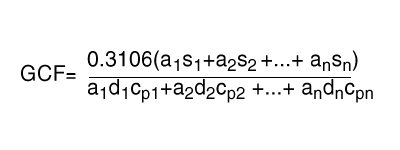Flow Measurement & Control Frequently Asked Questions
How do I select and develop a DeviceNet™ network?
What do the most common fittings on MKS Instruments products look like?
Where can I find a Gas Conversion Chart of gas correction factors for thermal-based flow?
How do you calculate a gas correction factor if you flow a mixture of gases?
For gas mixtures, the calculated mass flow controller (MFC) gas correction factor (GCF) is not simply the weighted average of each component's GCF. Instead, the GCF (relative to nitrogen) is calculated by the following equation (for n gases):

Here, a1 through an are the fractional flows of gas 1 through n; s1 through sn are the molecular structure factors; d1 through dn are the standard densities; and cp1 through cpn are the specific temperatures. Values for s, d, and cp are available for most gases; many are listed in our MFC manuals. The values for a1 through an will depend upon the application. (Remember that a1 through an must add up to 1.0.)
Molecular Structure correction factor(s):
- 1.030 for monoatomic gases
- 1.000 for diatomic gases
- .941 for triatomic gases
- .880 for polyatomic gases (four or more atoms)
Example:
Gas 1 = argon at 150 sccm
Gas 2 = nitrogen at 50 sccm
What is an sccm?
sccm stands for Standard Cubic Centimeters per Minute. Where "Standard" means referenced to 0 degrees Celsius and 760 Torr.
What GCF do I use if flowing a gas that is different than the gas that the MFC was calibrated for?
Take the GCF of the gas that you are flowing and divide that by the GCF of the gas that the MFC was calibrated for. Example: the MFC is calibrated for 100 sccm of Argon (GCF 1.39) and you are flowing CO2 (GCF = 0.7) the resulting effective GCF would be 0.7/1.39 = 0.50. Therefore the 100 sccm Argon instrument will be flowing 50 sccm of CO2 at full scale.
What should the GCF (gas correction factor) be if I am flowing the gas that the instrument is calibrated for?
The GCF would be 1.

 Ultra-High Velocity
Ultra-High Velocity